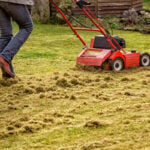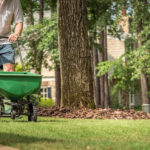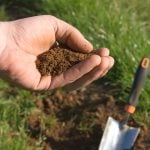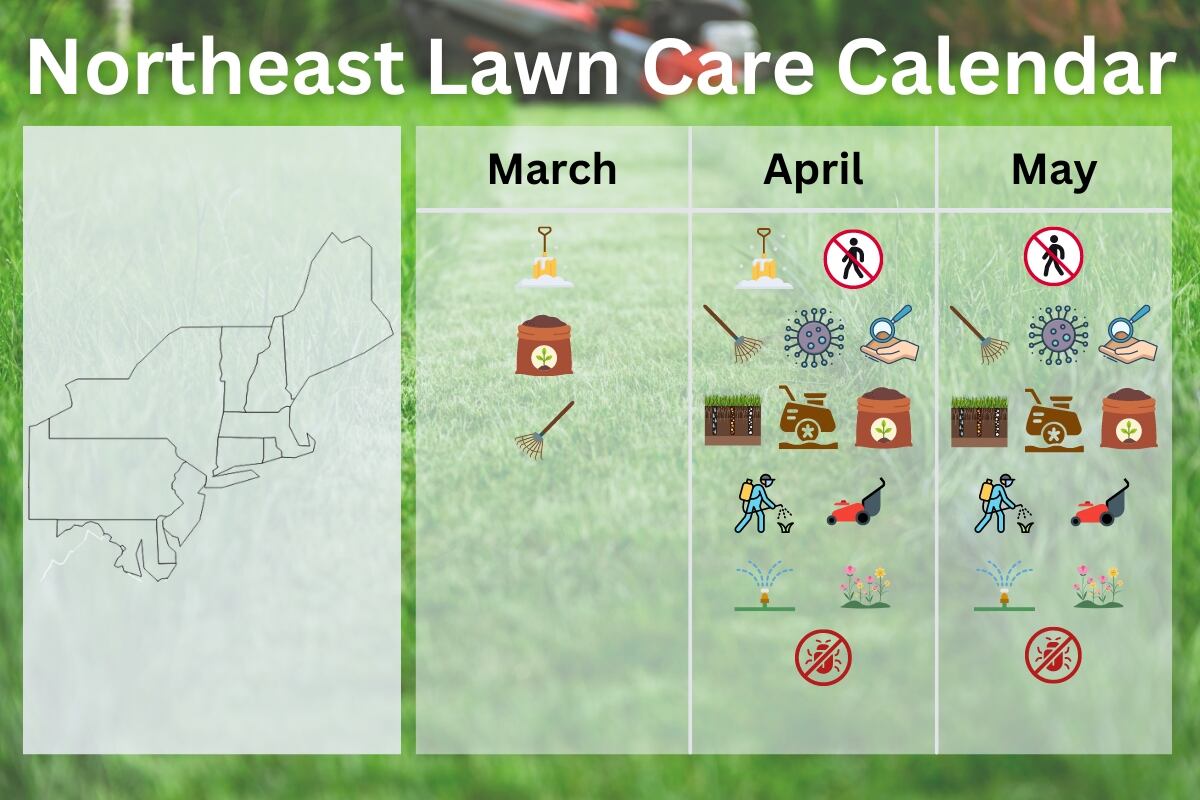
The Northeast experiences colder spring temperatures than most of the country, meaning our lawn care schedule starts much later than the Southern states. Don’t know what to do this spring and – more importantly – when to resume lawn care? Read our spring lawn care tips for the Northeast to learn more.
Is my state part of the Northeast? According to the U.S. Census Bureau, the Northeast region consists of nine states, including all of New England. These states include:
- Connecticut
- Maine
- Massachusetts
- New Hampshire
- New Jersey
- New York
- Pennsylvania
- Rhode Island
- Vermont
Sometimes, the states of Delaware and Maryland, as well as the District of Columbia (Washington, D.C.), are lumped in with the Northeastern states. We’ll be touching on Delaware and Maryland in this article, too.
In this spring lawn care calendar, you’ll find:
- March Spring Lawn Care Tips for the Northeast
- April Spring Lawn Care Tips for the Northeast
- May Spring Lawn Care Tips for the Northeast
- FAQ About Spring Lawn Care in the Northeast
March Spring Lawn Care Tips for the Northeast
March in the Northeastern U.S. often sees freezing or close to freezing temperatures, with the whole region averaging around 36 degrees Fahrenheit during this month. It’s generally too cold in the Northeast for you to do much outside in your yard at this time.
That doesn’t mean there’s nothing for you to do. In fact, March is the perfect time to start preparing for the busy lawn care season ahead of you.

Tip 1: Spread the Snow Evenly
Most of the Northeast still gets snow throughout March, with New York, Vermont, New Hampshire, Maine, and parts of Massachusetts getting around 10 to 20 inches of snowfall.
Snow is not necessarily bad; it can even insulate your plants. However, it becomes harmful to your lawn and garden if it’s uneven, especially if you shovel snow off of your driveway and onto your lawn. Uneven snow on a lawn can lead to your lawn waking up from dormancy out of sync or cultivating lawn diseases like snow mold because of the excess moisture.
To prevent a headache later in spring, spread the snow evenly across your lawn with a rake or a shovel. Homeowners living in the southern half of the region, like Pennsylvania, Connecticut, Rhode Island, and New Jersey (as well as Delaware and Maryland) shouldn’t slack off even if you receive less snow overall.
If you find a snowless spot on your lawn – however unlikely it may be – take care not to step on it especially if it’s wet. Your grass is quite fragile during this period and won’t be able to recover until later in spring.

Tip 2: Buy Your Fertilizer and Weed Killers
March is a good time to buy lawn care supplies like fertilizer and herbicides. Don’t be fooled: It’s still too cold to lay these down on your grass in March. However, buying them early means you won’t be caught off-guard when it becomes warm enough for spring feeding and weed killing. This is especially true for pre-emergent herbicides, which need to be applied early to have any effect.
Buying early may also save you some money. There’s not much demand for fertilizers and weed killers early in spring because they can’t (or rather, shouldn’t) be used yet.
Tip 3: Get Your Lawn Care Tools Ready for Spring
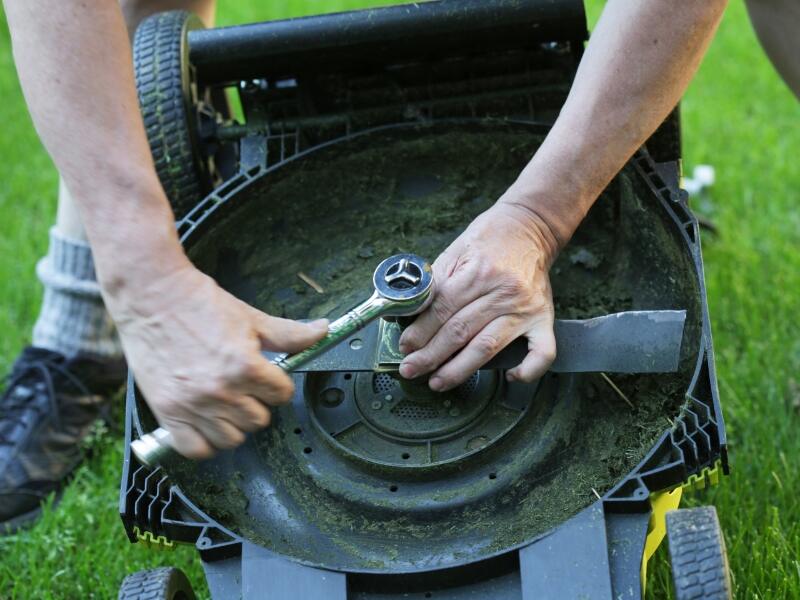
You’ll want to get your lawn care tools in tip-top shape well before you need to use them. Here’s a checklist for what you might need to inspect this month:
- Lawn mower
- String trimmer
- Basic yard tools: Shovels, rakes, and cutting tools
However, you shouldn’t start firing up your tools willy-nilly. We don’t advise adding fuel until just before you need to cut your grass (which isn’t until later in spring). Instead, focus on these:
- Sharpen your blades. Sharpen the blades of your mower and your cutting tools, especially if you didn’t in the winter. Dull blades make cutting more difficult and sloppy, and they also damage your turf and other plants. Don’t know how to sharpen your mower blades? Read our article on “How to Sharpen Mower Blades” here.
- Replace your string trimmer line. If you have a weed eater, then check how much string is left in there. It’s also smart to replace the trimmer line as it could have become brittle over the winter. If you need help with stringing a weed whacker, read our guide on “How to String a Weed Eater.”
Get your lawn care tools ready now and you will lessen your maintenance later in the spring. If you can’t (or don’t want to) take care of your tools yourself, take your tools to a lawn care professional who offers maintenance services. If you bring your lawn mower in for a tune-up in early spring, you’ll beat other homeowners to the punch.
How LawnStarter can help: Don’t want to mess with sharpening mower blades and stocking up on fertilizer and weed killers – much less mowing nearly every week later on? Hire a LawnStarter pro near you to take lawn care off your hands. We have local pros across the Northeast.
April Spring Lawn Care Tips for the Northeast

April brings warmer temperatures, so you can start your spring lawn care prep and routine.
April temperatures: The lower half of the Northeast and most coastal areas experiencing the last spring frosts and freezes by the end of the month. On average, this region has temperatures hovering around the high 40s.
Snowmelt and lawn hydration: It also starts snowing less and less in April. Most of the Northeast region gets only 2 inches of snow, with only the most inland areas of New York, Vermont, New Hampshire, and Maine getting up to 8 inches of snow. The snow will start melting, too. Combined with spring showers, the snowmelt will keep your lawn hydrated throughout this month.
In general, the spring lawn care season kicks off this month for most of the Northeast, except for the most northern and inland areas. This also includes the bonus states of Delaware and Maryland, as well as Washington, D.C.
What grass do you have on your lawn? It’s important to know what grass you have as they have different care requirements. The Northeast is home to mostly cool-season grasses such as:
- Kentucky bluegrass
- Tall fescue
- Fine fescues
- Perennial ryegrass
- Bentgrasses (more common on athletic fields and golf courses, but grown in lawns because of their lovely green color despite high maintenance requirements)
- Creeping bentgrass
- Colonial bentgrass
Some homeowners in the southern part of the region have also adopted Zoysiagrass as a lawn grass. This warm-season grass is more often seen as a weed because it turns brown once the fall frost sets in.
Tip 1: Keep Spreading the Snow and Keep Off Wet Grass
Although falling snow becomes an increasingly rare sight as April goes by, you may still find some snow on your lawn. If you do have snow on your lawn, spread it around evenly to help it melt faster.
For most of the Northeast, snow will be replaced by April showers that bring May flowers (and regular use of your lawn mower). The snow and showers mean wet grass and soggy, muddy soil.
Stay off the wet grass. Wet soil is more likely to become compacted, which is bad for your lawn’s health. Wet grass is also less resilient and might get damaged when walked on.

Tip 2: Get Your Lawn Mower and Other Lawn Tools Ready
Mowing season comes a bit earlier for the southern areas of the Northeast region, with homeowners possibly getting the first mow in by the end of April if you have cool-season grass (Kentucky bluegrass, fine fescues, tall fescue, perennial ryegrass, creeping bentgrass, and colonial bentgrass).
That means you should get your lawn mower ready before you need to cut your grass for the first time this spring. Don’t know what to do to get your mower up and running for spring? Read this list to find out what to do:
- Sharpen blades. Ideally, you should have sharpened your mower blades in March. If you haven’t yet, now is the time.
- Check if your mower’s parts need to be lubricated. Pivot points, wheel axles, and other moving parts and joints will need to be lubricated every once in a while for smooth operation.
- Clean off dirt and debris. A lawn mower caked in dirt won’t cut grass properly. (You can learn how to properly clean the underside of your lawn mower in our handy guide).
- For gas-powered lawn mowers:
- Check spark plugs and air filters. Test to see if spark plugs are properly igniting your equipment and check if the air filters need changing. (Read our article on “How to Change Spark Plugs on a Lawn Mower” and “How to Clean and Change a Lawn Mower Air Filter” to learn how to do it yourself).
- Check oil levels. Make sure the oil levels are not low (you can use a dipstick for that). (Here’s a how-to guide on changing oil in a lawn mower if you want to learn how to do it yourself).
- Add fresh gas. When you winterize your lawn mower, typically you’d drain it of gas. Even if you didn’t, you should replace the gas and add fresh gas to the tank.
- For battery-powered lawn mowers:
- Batteries. If you have a battery-powered mower, properly charge your lawn mower batteries. Inspect them for rust, too. If your batteries won’t work, it may be time to replace them.
- If you have a lead-acid battery, check the water levels and add distilled water if they’re running low.
- Batteries. If you have a battery-powered mower, properly charge your lawn mower batteries. Inspect them for rust, too. If your batteries won’t work, it may be time to replace them.
To learn more, you can read our guide on “DIY Lawn Mower Maintenance.”
These tips also apply to other lawn care tools in your arsenal, such as lawn edgers, string trimmers, and leaf blowers.
Tip 3: Clean Up Your Lawn
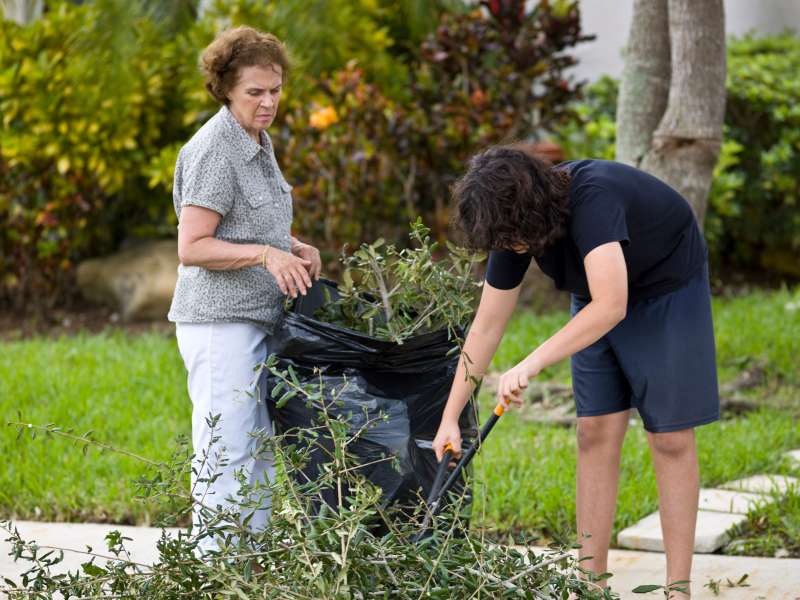
Once all the snow has melted and before it’s time to cut your lawn, you should clean up leaves, branches, twigs, and other debris. A clean lawn is much easier to work with, but it’s also healthier for your grass. A lawn full of debris is more prone to getting diseases, pests, and thatch.
You can use a leaf blower or a rake to clean your lawn. While it’s less convenient, using a rake might be a better choice as it can remove thatch and matted grass. Matted grass, which is caused by snow molds, compacted soil, and overwatering, can prevent new grass from growing.
If you plan to rake your lawn, wait until your lawn is dry. Wet, muddy soil is easier to work with, but you might pull up healthy grass while raking your lawn.
Homeowners in these areas will most likely have melting snow by the end of the month:
- Southern half of Pennsylvania
- New Jersey
- Parts of Connecticut
- Parts of Rhode Island
- Coastal areas of Massachusetts
- Long Island and the coastal areas of New York
- Delaware, Maryland, and D.C.

Tip 4: Look for Signs of Snow Mold and Other Lawn Diseases
The cool and humid weather of spring can foster fungi that cause lawn diseases. The melting snow doesn’t help with the moist conditions that fungi love. Read the list below to find out about some common lawn diseases and some articles that can teach you how to get rid of them:
- Snow molds. Pink and gray snow molds are the No. 1 lawn disease to look out for in spring. Snow molds cause patches of matted grass that can look gray, tan, or pink. (Read our article on “How to Get Rid of Snow Mold” to learn more about this lawn disease).
- Fairy rings and mushrooms. There are three types of fairy rings. They can look like dark green circles of grass, brown circles of grass, or circles of mushrooms. (Read our article on fairy rings to learn more about this lawn disease).
- Anthracnose. This causes reddish-brown lesions to appear on grass blades. Over time, reddish-brown patches of grass will form on your lawn. They can also appear on trees and other plants. (Read our article on “How to Get Rid of Anthracnose” to learn more about this lawn disease).
- Leaf spot. Leaf spot causes grass to develop small brown spots. These spots enlarge over time and develop brown or purplish-red borders. Leaf spot progresses to melting out. (Read our article on “How to Get Rid of Leaf Spot and Melting Out” to learn more about this lawn disease).
- Melting out. This progression of leaf spot kills grass by rotting its crown and roots. Over time, your lawn thins out.
If you discover symptoms of any of these lawn diseases, it’s best to control the diseases as soon as possible. Otherwise, your lawn might sustain significant damage that only time and proper care can heal. Hire a local LawnStarter lawn care pro if you don’t know how to (or don’t want to) deal with lawn diseases.
While not a disease, moss also pops up and grows on Northeast lawns during the humid months of spring. It’s not harmful to your lawn, per se. However, turf won’t grow in areas with moss, so you’ll need to remove it before you can patch up bare spots on your lawn. You can read our article on “How to Remove Moss From Your Lawn” to learn more.

Tip 5: Conduct a Soil Test and Lime Your Lawn (If Needed)
Turfgrasses thrive best when they’re in their ideal environment. Part of the ideal environment is soil with the proper pH level, as soil that is too acidic or alkaline can make it more difficult for your grass to get the nutrients it needs. Some weeds also prefer more acidic and alkaline soils; combined with weakened turf, they can easily take over your lawn.
Conduct a soil test to find out if your soil is in the proper pH range. You can use a DIY test kit — which can be bought online and in home improvement stores — or send soil samples to a private lab or your local Cooperative Extension office. Here is the ideal pH range for the most common lawn grasses in the Northeast:
| Grass Type | Preferred Soil pH |
| Fine fescue | 6.0 – 6.5 |
| Kentucky bluegrass | 6.0 – 7.5 |
| Perennial ryegrass | 6.0 – 7.0 |
| Tall fescue | 5.5 – 6.5 |
| Creeping bentgrass | 5.5 – 6.5 |
| Colonial bentgrass | 5.5 – 6.5 |
| Zoysiagrass (further south) | 6.0 – 6.5 |
Most of the Northeast – save for parts of New York – has acidic soil, with New Jersey, Massachusetts, Vermont, New Hampshire, Maine, northern New York, and Long Island having 5.0 or lower pH. Rarely do homeowners in this region need to lower your lawns’ pH levels. If your soil is acidic, then you can lime your soil to raise its pH level.
Note: Don’t apply lime on soggy soil.
Soil tests also reveal the nutrient levels of your lawn. You’ll want to know if your soil is missing nutrients and what specific nutrients it needs. The most important nutrients you need to keep track of are the macronutrients: nitrogen, phosphorus, and potassium.
Conduct a soil test only if the ground has thawed and the soil is not soggy. Otherwise, you might have difficulty getting the soil samples and the results may be inaccurate.
Tip 6: Aerate Your Lawn (If Needed)
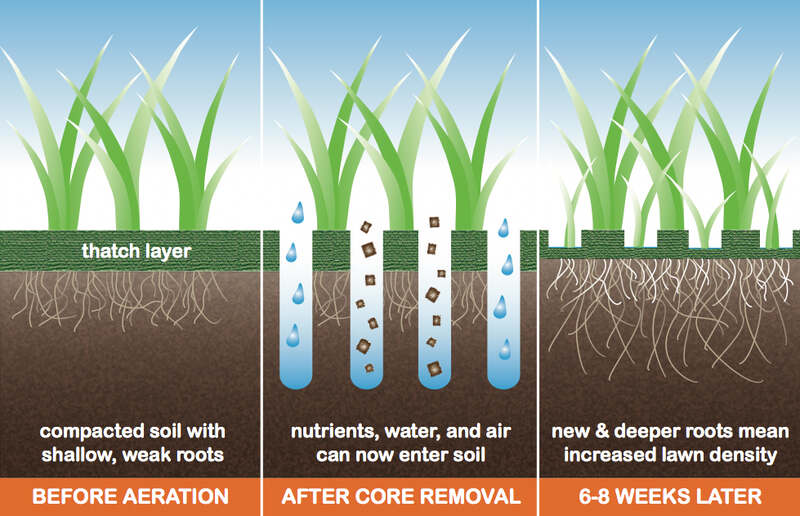
Compacted soil prevents nutrients, water, and sunlight from getting to your turfgrass’s root system. Aeration alleviates that by poking holes in the soil to make more space. However, most lawns don’t actually need to be aerated annually – only those that get walked on often or those with a lot of clay. The Northeast doesn’t have a lot of clay soil, though.
Here are the signs your lawn has compacted soil:
- Puddles form after rain or irrigation
- Increased water runoff
- Thinning grass
There are two main types of aeration: spike aeration and core aeration. Spike aeration works by poking holes in the soil using a tool, like a spading fork. It’s a quick and easy way to alleviate soil compaction, but it’s a short-term solution. It only pushes soil aside to make temporary space for water, nutrients, and air to flow.
On the other hand, core aeration is done with a core aerator, which penetrates the soil and removes soil plugs. This is the best remedy for compacted soil, as it actually removes soil from your lawn instead of pushing it aside. The soil plugs also return nutrients to your lawn as they break down.
Note: Don’t aerate your lawn in April if you are growing Zoysiagrass. Generally, it’s still too cold for Zoysia to resume growing, so it won’t be able to recover well from the damage. Zoysia grows only as far north as the coastal areas of Massachusetts, Rhode Island, and Connecticut.
Here is a short guide on aerating your lawn:
- Mow your lawn to its ideal height. (See chart below.)
| Grass Type | Recommended Mow Height (Inches) |
| Fine fescue | 1.5 – 4 |
| Kentucky bluegrass | 2.5 – 3.5 |
| Perennial ryegrass | 1.5 – 2.5 |
| Tall fescue | 1.5 – 3 |
| Creeping bentgrass | 0.125 – 0.5 |
| Colonial bentgrass | 0.5 – 1 |
| Zoysiagrass | 1 – 2 |
- Water your lawn a day or so before you plan to aerate it. Don’t water your lawn if it has rained.
- Mark sprinkler heads on your lawn so that you don’t hit them.
- Starting at one edge, push the aerator across your lawn in rows. Overlap your rows a little for an even aeration.
- Make a second pass with your aerator, but at a 90-degree angle to when you first aerated your lawn.
- Leave the soil plugs to dry on your lawn for a few days.
- Using the back of a rake, break up the soil plugs.
If you can postpone aerating your lawn to fall, then do so. It’s less stressful for the grass as it doesn’t have to contend with the coming summer heat.
Tip 7: Dethatch Your Lawn (If Needed)
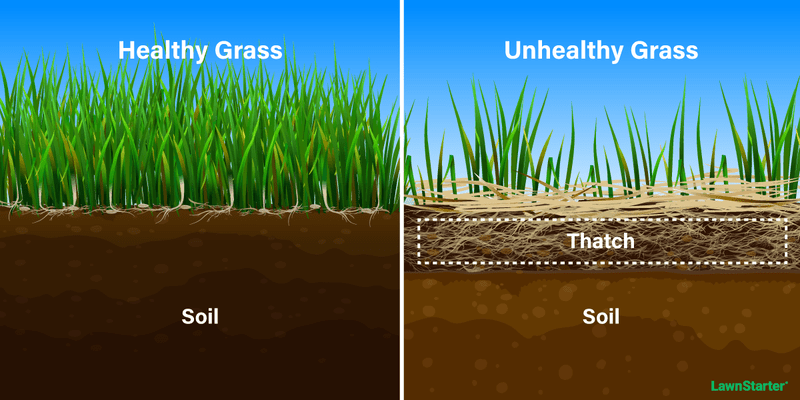
One of the major enemies of lawns is excess thatch. Thatch is the spongy layer of dead and living organic matter. It can house pests and invite disease if it’s too thick. Dethatching removes excess thatch from your lawn, but it’s an invasive lawn procedure that should be done only when needed. If you can, postpone dethatching until fall.
The best way to check if your lawn needs to be dethatched this spring is by digging out 3-inch-deep soil samples. The thatch layer can be found between your turf and the soil itself. Measure how thick it is with a ruler; if it’s more than ½-inch thick, it’s time to dethatch.
Is my lawn susceptible to thatch? If you have a tall fescue or a perennial ryegrass lawn, then congrats, you have a lawn that isn’t prone to thatch buildup. The following grasses are prone to thatch, especially when given too much nitrogen fertilizer and water:
- Kentucky bluegrass
- Fine fescue
- Creeping bentgrass
- Colonial bentgrass
- Zoysiagrass
If you need to dethatch your lawn, you’ll need a dethatching rake, dethatcher, or verticutter. Here is a quick guide to dethatching your lawn:
1. Mow your lawn to almost half of its recommended height. (See recommended mowing heights below.)
| Grass Type | Recommended Mow Height (Inches) |
| Fine fescue | 1.5 – 4 |
| Kentucky bluegrass | 2.5 – 3.5 |
| Perennial ryegrass | 1.5 – 2.5 |
| Tall fescue | 1.5 – 3 |
| Creeping bentgrass | 0.125 – 0.5 |
| Colonial bentgrass | 0.5 – 1 |
| Zoysiagrass (southmost areas) | 1 – 2 |
2. Dethatch:
- If you’re using a dethatching rake, dig into the thatch with the rake tines and pull upward.
- If you’re using a dethatcher or verticutter, read the instruction manual carefully. Regardless of how yours works, you don’t want the blades to cut deeper than ½-inch into your soil.
3. Rake the loosened thatch and remove it from your lawn.
It’s best to dethatch during your lawn’s growing season so it can recover more easily from the damage. So, cool-season lawns are fine to be dethatched from April until the summer, but Zoysia lawns should be dethatched when it’s closer to summer.

Tip 8: Use Pre-Emergent Herbicides
Near the end of April, New Jersey, Pennsylvania, Delaware, Maryland, and the District of Columbia (Washington, D.C.) will start getting temperatures warm enough for you to apply pre-emergent weed killers. Pre-emergent herbicides prevent these common summer annual weeds in the Northeast:
- Crabgrass (Here’s a guide on “How to Get Rid of Crabgrass.” We recommend using Tupersan if you will overseed your lawn or grow a new lawn.)
- Black medic
- Spotted spurge
- Yellow woodsorrel (summer grass, sheep’s clover, shamrock, sleeping beauty, oxalis)
- Purslane
- Lambsquarters
However, pre-emergents won’t work very well against the following perennial weeds if they’re already established:
- Dandelions (If you want to learn more, read our article on “How to Get Rid of Dandelions.”)
- Broadleaf plantain
- Nutsedge (Nutsedge is an exceptionally tricky weed to get rid of. You can read our guide on “How to Control Nutsedge in Your Yard” for help.)
- Prickly lettuce
- Ground ivy (Creeping Charlie)
- White clover (Do you need to kill clover? Here’s a guide on “How to Get Rid of Clover and Not Kill Grass.”)
- Yellow woodsorrel (it can be an annual and a perennial)
Pre-emergents will work only on weed seeds, but they’re not much help if weeds are already on your lawn. You’ll need to use post-emergent herbicides on weeds later in spring (and summer) if they’ve already germinated.
Apply pre-emergents when the soil temperature is 55 degrees Fahrenheit for at least 48 hours. In air temperatures, that is around 65 degrees Fahrenheit. However, it’s still best to use a soil thermometer to make sure the soil is at the proper temperature before applying pre-emergent.
Another good indicator of when to apply pre-emergent is to look for forsythia blooms, which appear in early spring but can delay flowering if the winter is especially harsh. When these golden flowers blossom, it’s time to apply pre-emergent herbicides. You have about 2 to 3 weeks; don’t wait for the forsythia flowers to drop.
Note: If you’re going to dethatch and aerate your lawn this spring, apply pre-emergents after. You can dethatch and aerate either before applying pre-emergents or postpone these procedures to fall.
Tip 9: Overseed Bare Spots (If Needed)
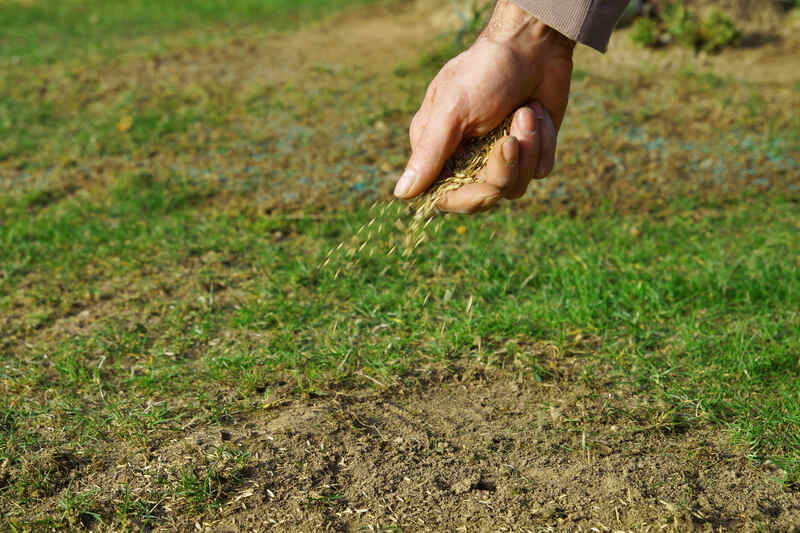
Throughout the year, your lawn may develop bare patches from diseases or foot traffic. A patchy lawn is unsightly, lowers your curb appeal, and may earn you a visit from your HOA. Grass can typically recover and fill in the bare spots over time, but you can also overseed your lawn instead. We recommend this especially if you have bunch-type grasses.
Bunch-type grasses like tall fescue, most fine fescues, and perennial ryegrass recover very slowly as they don’t typically spread. If you have a mix of grasses on your lawn, this shouldn’t be an issue.
Overseeding is simply the act of spreading grass seed on your existing lawn to fill bare patches and thinning turf.
Spring isn’t the best time to overseed most Northeast lawns because cool-season lawns grow best in the fall. You should overseed in spring if your lawn desperately needs it, though. Check out “Clear Signs You Need to Overseed Your Lawn” to help you decide.
- Cool-season grasses like Kentucky bluegrass, fescue grasses, perennial ryegrass, and creeping bentgrass will need to be planted when the soil temperatures are consistently between 50 and 60 degrees Fahrenheit. This translates to around 60 to 70 degrees in air temperatures.
- Zoysiagrass should be seeded when the soil temperature is over 65 degrees, which is roughly 75 degrees Fahrenheit in air temperature. In the Northeast, this usually means waiting until June.
Don’t overseed until after you’ve dethatched or aerated your lawn (if you plan to do it in the same season). These treatments will disturb your grass seeds and may interfere with their germination.
You can read our guide on “How to Overseed Your Lawn” to learn how to do this DIY.
Don’t know what grass you should overseed your lawn with? You can read the following articles to find out the best grass types for your lawn:
- Connecticut
- Boston, MA
- New Hampshire
- New Jersey
- New York
- Pennsylvania
- Rhode Island
- Vermont
- Delaware
- Baltimore, MD
- Maine
April is also a good time to start a new lawn if you want to (at least, for cool-season grass). While fall is still the best time to plant cool-season grass seeds, spring has temperatures cool enough for these seeds to germinate. If you want to learn more about planting grass seed, you can read our how-to guide here: “How to Plant Grass Seed.”
Tip 10: Fertilize Your Lawn
Most Northeast lawns don’t need much fertilizer in the spring, especially if they’ve been fed last fall. However, you should fertilize your lawn if your soil test indicates that your soil lacks nutrients.
Here are some tips you can follow to fertilize your lawn properly:
- Learn what N-P-K ratio you need. N-P-K stands for nitrogen, phosphorus, and potassium, which are the three most important nutrients your turf needs. Fertilizer has different N-P-K ratios, so pick a fertilizer that suits your lawn’s needs. Your soil test results may tell you what fertilizer ratio your lawn needs.
- Fertilize a week after using herbicides. If you need to apply herbicides to kill weeds, wait at least a week to fertilize.
- Fertilize lightly and use a spreader. Don’t use too much fertilizer as it can cause your grass to grow too fast and weaken its roots. Using a spreader will help you spread fertilizer evenly on your lawn, which prevents nitrogen burn. Nitrogen burn happens when too much fertilizer is dumped on your turf.
- Wear protective gear to prevent nitrogen burns on yourself. Ideally, you should use gloves, long sleeves, long pants, and a mask.
- Read the instructions for your fertilizer. Some lawn fertilizers have restrictions. Your fertilizer should also tell you if it needs to be watered in after it’s applied.
- Wait for a calm day before applying fertilizer. It’s best to feed your lawn when it’s not windy or rainy.
- Fertilize in a grid. Start at the perimeter of your lawn, and then go to the center. Fertilize from north to south, then east to west.
- Return excess fertilizer that has landed on your walkway or driveway to your lawn using a broom or a leaf blower.
How much fertilizer will you need? Generally, most lawns need 1 pound of nitrogen per 1,000 square feet. However, 1 pound of nitrogen doesn’t mean 1 pound of fertilizer. Check your fertilizer’s product label to find out how much you can cover with one package. Usually, 14 to 20 pounds is enough to cover a 5,000-square-foot lawn.
Don’t know how many square feet your lawn is? Here are some easy ways to calculate your lawn’s square footage:
- If you know your property’s square footage and your home’s square footage, then subtract your home’s square footage from your property’s square footage. The result is your lawn’s square footage.
- Take a measuring tape or measuring wheel and measure around the perimeter of your lawn. Multiply the length times the width to get your lawn’s area in square feet. However, this won’t be as accurate if your lawn isn’t a rectangle or square.
To learn more, you can read our article on “How to Fertilize Your Lawn.”
When should I fertilize my lawn? Your soil temperature should be at least 55 degrees Fahrenheit before you fertilize your cool-season grass. This translates to around 65 degrees in air temperature. In April, homeowners in the coastal areas of New Jersey, Delaware, and Maryland can likely start fertilizing your lawns by the end of the month.
Don’t fertilize your Zoysiagrass lawn until the soil temperatures have been 65 degrees or warmer for a few weeks (around 75 degrees in air temperature). In the Northeast, this means waiting until June at the earliest for the most southern parts of the region.
Tip 11: Mow Your Lawn Properly
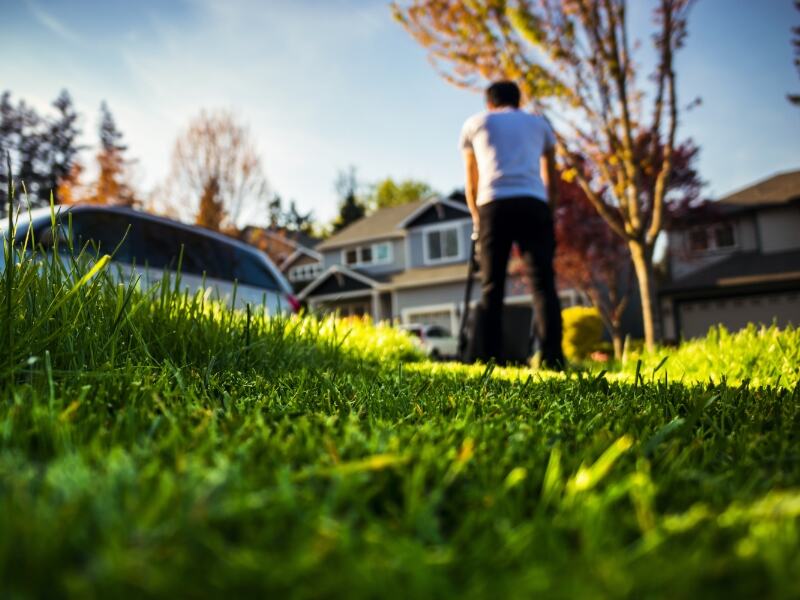
As we said earlier, April brings warmer temperatures that spur cool-season grasses to resume growing in the lower half of the state. Cool-season grasses grow most vigorously in 60- to 75-degree air temperatures. So, homeowners in the following states may have to check on their grass to see if they can start mowing by the end of the month:
- Connecticut
- Massachusetts (mostly coastal areas)
- New Jersey
- New York (mostly coastal areas)
- Pennsylvania
- Rhode Island
- Delaware
- Maryland
Note: Zoysia doesn’t come out of winter dormancy until the temperatures have consistently hovered around 60 degrees Fahrenheit or hotter. It will start growing only at that temperature, so it might take a few weeks before you can mow your Zoysia lawn.
When should I mow this spring? While temperature is a good indicator of when grass should start growing, it doesn’t mean that you should bust out the lawn mower as soon as the temperatures stay consistently warm.
You should wait until the grass is tall enough before mowing. Consult the table below to find out how tall your grass should be before mowing:
| Grass Type | Recommended Mow Height (Inches) | Cut When Grass is This Tall (inches) |
| Fine fescue | 1.5 – 4 | 2.25 – 5.25 |
| Kentucky bluegrass | 2.5 – 3.5 | 3.25 – 4.5 |
| Perennial ryegrass | 1.5 – 2.5 | 2 – 3.25 |
| Tall fescue | 1.5 – 3 | 2.5 – 4 |
| Creeping bentgrass | 0.125 – 0.5 | 0.5 – 0.75 |
| Colonial bentgrass | 0.5 – 1 | 0.75 – 1.5 |
Here are some lawn mowing tips you’ll want to remember when it’s time for the first mow of the season:
- Keep your mower blades sharp. Instead of cleanly cutting your grass, dull blades tear your grass. This stresses out your grass and may turn the tips brown.
- Cut only 1/3rd of your grass height when you mow. Any more than that may stress out your lawn.
- Mow down to your turf’s ideal height. Cut your grass too short and you can damage the roots and cause your lawn to become weak and susceptible to lawn diseases and lawn pests. Try to cut down to the higher end of the recommended height, though. Consult the table below to find out your turf’s ideal height.
- Mow in a different pattern every time you mow. This will force your grass to grow in different directions, which makes it more resilient.
- Don’t mow when your lawn is wet. Wet grass can clog your mower, making it spit out clumps of wet grass that can suffocate your lawn.
For more tips, read this handy guide on proper mowing.
Pro Tip: When you mow, leave the grass clippings on your lawn instead of bagging them. These lawn-mowing residuals can help add nutrients and a boost of natural, organic fertilizer without the need for expensive chemicals. It’s the beautiful cycle of life! You can learn more in our article about grasscycling.

Tip 12: Prepare Your Sprinkler System for Spring
Before the winter set in last year, you likely winterized your irrigation system to prevent water from freezing over and bursting the pipes. Now that it’s warmer, it’s time to prepare it for spring irrigation, even though the snow melt and spring showers will likely keep your lawns watered.
You should turn on your sprinklers only when all threats of frost have passed; otherwise, water in the pipes could freeze and damage your sprinkler system. If you live in these states you will likely be able to turn on your sprinklers by the end of April:
- New Jersey
- Rhode Island
- Delaware
- Maryland
Of course, the best time to turn your sprinklers in spring is when it’s no longer freezing at night. Always check the weather forecast for the predicted last day of spring frost.
Here’s how to restart your sprinklers in the spring:
- Clean your sprinkler heads. Debris can clog your sprinklers.
- Locate your system’s main shut-off valve. This will usually be in a crawlspace or basement.
- Open the valve carefully until it’s half-open. After a few minutes, run each sprinkler zone for at least 3 minutes. This will acclimate the pipes to the water pressure.
- Walk around your lawn and look for issues. Don’t be worried if you see your sprinklers blowing out air or sputtering out water; it should stop after a minute. If it doesn’t stop doing that, make a note as something may be wrong with your valves or sprinkler heads.
- Open the shut-off valve all the way.
- Set up your sprinklers based on what your lawn needs. Keep in mind that snow melt and spring showers help water your grass, so you may not need to let your sprinklers run yet:
- Cool-season grass: 1 to 1.5 inches weekly
- Zoysiagrass: 1 inch weekly
Here are some warning signs you might see with a broken sprinkler system:
- Wild or odd streams of water
- Runoff and leaks
- Puddles
- Leaks
- No water
These problems may be caused by broken, cracked, and clogged parts. There are many parts that make up a sprinkler system — some are even electrical. It’s better to contact a pro to fix your sprinkler system rather than take a crack at it yourself if you don’t have a lot of tinkering experience.
Tip 13: Start Landscaping
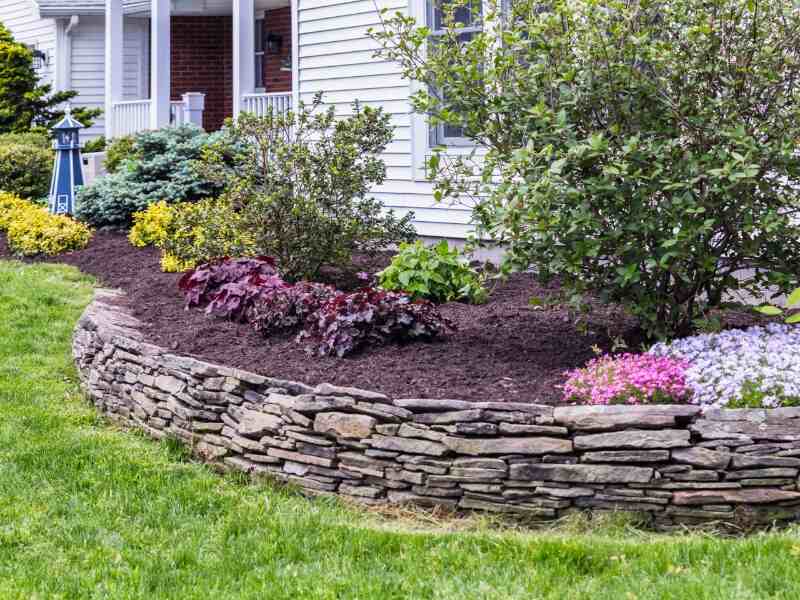
Spring is the season of new life, so it’s the perfect time to start adding to your landscape. You can start preparing your landscape beds once you’re sure that temperatures won’t drop below freezing again.
The following areas historically have last frost dates within April:
- New Jersey
- Parts of New York (Long Island and coastal areas)
- Parts of Pennsylvania
- Parts of Connecticut
- Parts of Massachusetts
- Parts of Rhode Island
- Delaware
- Maryland
Here is a landscaping checklist you can refer to this spring:
- Existing flowers. If you want to encourage your flowers to bloom, you’ll need to prune the old seed heads and dead flowers. Called deadheading, this process involves cutting these dead parts just above the first set of healthy leaves.
- Garden beds. You should prepare your garden beds as soon as your soil temperature consistently reaches 60 Fahrenheit and above.
- Soil. Your soil should be only slightly moist and rather crumbly before you add new plants to your garden. To check if your soil is ready, take a handful of it and squeeze; if it clumps up and drips, it’s not yet ready.
- Mulch. The best time to top off your mulch is in the spring after all threats of frost have passed. Some of its benefits include preventing weed germination and temperature regulation. Organic mulches, like grass clippings, leaves, and bark can also supplement your lawn fertilization as it breaks down.

Tip 14: Watch for Lawn Pests
Spring brings many baby critters. Unfortunately, this also includes baby bugs that like munching on your turfgrass. Here are some pesky pests that Northeastern homeowners may find on their lawns:
- Chinch bugs (Will be more active in New Jersey, Delaware, and Maryland. Read how to get rid of them here: “What Are Chinch Bugs and How to Get Rid of Them”)
- White grubs (Read how to get rid of them here: “Lawn Grubs: How and When to Kill Them”)
- Ants (Read more about them here: “Common Types of Ants”)
- Sod webworms (Learn more about them here: “How to Get Rid of Sod Webworms”)
- Cutworms (Learn more in this article: “What are Cutworms?”)
Maintaining a healthy lawn is a good deterrent against these pests. Keep your thatch layer thin also is smart as some of these pests make their home in thatch.
You can use store-bought pesticides or DIY insect killers to get rid of pests. Hand-picking the bigger insects out of your grass and plants is also a viable option — if you don’t mind touching them, of course. If you don’t like the sight of bugs, you may want to hire a pest control pro instead.
If you live in the warmer parts of the Northeast you may see these lawn pests earlier than those in the north.
If all these lawn care tips sound like too much trouble, hire a lawn care pro to take lawn care off your to-do list. LawnStarter’s lawn care pros are local. We’re your neighbors, and we know how to care for lawns in the Northeast. And signing up is easy. Get an instant quote for lawn mowing and let us handle your yard work.
May Spring Lawn Care Tips for the Northeast
For homeowners in the warmer states of the Northeast, May is business as usual – lawn mowing every week. For those in the northern Northeast states, May is the start of the spring lawn care season. May is even warmer than April, but some states are just beginning to see their last frost dates. On average, the Northeast’s temperature is around 55 degrees Fahrenheit.
In May, snow has largely stopped falling over the Northeast and some areas will have had days when the temperatures have broken into the low 70s.
Let’s go over what homeowners should do during May.

Tip 1: Keep Spreading the Snow and Keep Off Wet Grass
The most northern parts of the Northeast region will have melting snow, which still needs to be spread evenly across your lawn for faster and more even melting.
As always, keep off the wet grass.
Tip 2: Get Your Lawn Mower and Other Lawn Tools Ready
Cool-season grass throughout the Northeast will have started growing by the end of May. If you have not sharpened your lawn mower’s blades, added fresh gas or replaced batteries, you should do that now. Same goes for your other lawn care tool. Get them ready for mowing season.
We already covered what to do in the April section of this article. In general, you want to make sure your blades are sharp, tools are clean, and energy sources (fuel or batteries) are working.
Tip 3: Clean Up Your Lawn
If you live in Maine, New Hampshire, Vermont, and the rest of New York, Pennsylvania, Connecticut, Rhode Island, and Massachusetts you may still have melting snow in May. Clean up your lawn as soon as you’re able to so your grass will be healthier and less disease-prone.
Remember, don’t rake your lawn when it’s wet or else you might pull up healthy grass.
Tip 4: Look for Signs of Snow Mold and Other Lawn Diseases
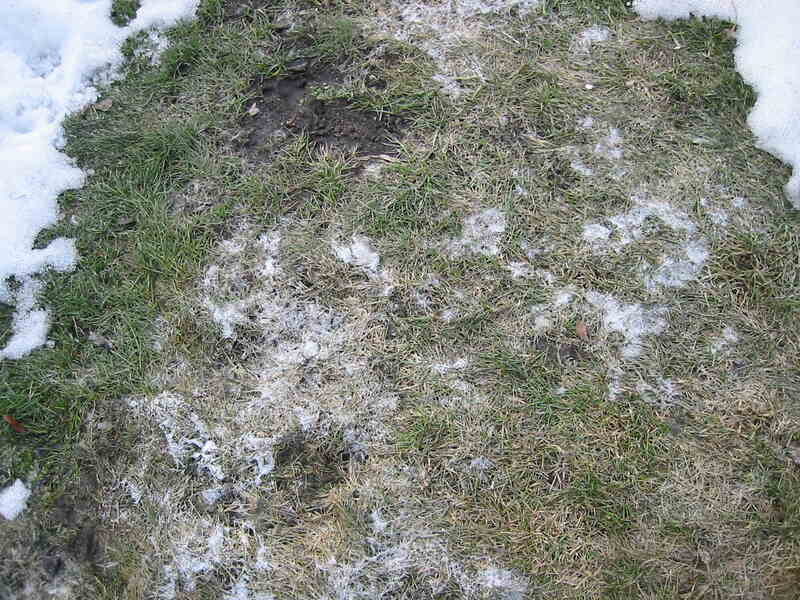
The areas of the Northeast that have melting snow will have to look out for snow mold and other lawn diseases. We’ve already covered snow molds, fairy rings, anthracnose, leaf spot, and melting out in the April section, but some other lawn diseases may rear their ugly heads around May:
- Red thread. Red thread causes irregular pink, reddish-brown, or orange spots on your grass. At a glance, red thread may look like strands of thread or cotton. Turf killed by this disease turns light pink or tan. (You can learn more in our article on “Red Thread and Pink Patch”).
- Dollar spot. Dollar spot causes tan spots to appear on your lawn. These spots range from 2 to 6 inches wide. (Read more in our article about “How to Get Rid of Dollar Spot”).
Red thread and dollar spot become more common due to the humidity and warming temperatures of late spring. In fact, they’re some of the most common spring lawn diseases in Massachusetts, Maryland, and Delaware.
Tip 5: Conduct a Soil Test and Lime Your Lawn (If Needed)
Now that the ground has definitely thawed, it’s time – if you live in Maine, New Hampshire, New York, Massachusetts, and Vermont – to do a soil test on your lawn.
The soil in these states – save for parts of New York – trends toward acidic. Acidic soil is bad for your grass and will need to be corrected. If you do find that your soil is too acidic, then you should lime your lawn.
Soil tests are also important for finding out the nutrient levels of your lawn, which you’ll need to know to fertilize it properly.

Tip 6: Aerate Your Lawn (If Needed)
If you haven’t aerated your cool-season lawn yet – but you plan to this spring – then May is the last window you have to do it. Aerating compacted soil is useful for any lawn, but it’s a stressful process for your grass. Your cool-season grass will already be stressed out once summer comes; you don’t need to stress it out even more.
Otherwise, you should wait for fall to aerate your cool-season lawn (unless you have a Zoysia lawn).
If you are growing Zoysiagrass, then you should wait until the temperatures warm up to 60 degrees Fahrenheit. As a warm-season grass, Zoysia wakes up from winter dormancy later in the spring, when the days become warmer.
Homeowners in Delaware, Maryland, Connecticut, New Jersey, Massachusetts (coastal areas), and Rhode Island can probably aerate their Zoysia lawns at the end of the month.

Tip 7: Dethatch Your Lawn (If Needed)
May is also the last window of opportunity to dethatch your lawn this season (at least, a cool-season one). Dethatching is also a stressful but necessary procedure – at least, if you have thatch. Your cool-season grass needs time to recover as dethatching can thin out your grass. If you can’t dethatch your lawn this month, then we recommend waiting until fall.
Zoysiagrass lawns should be dethatched when the conditions are good enough to aerate; so, when the days hover around 60 degrees. The good news is that you can do this anytime throughout the summer if you can’t do it this month.
If you live in Delaware, Maryland, Connecticut, New Jersey, Massachusetts (coastal areas), and Rhode Island you can probably dethatch your Zoysia lawn at the end of May.
Tip 8: Use Herbicides to Kill Weeds
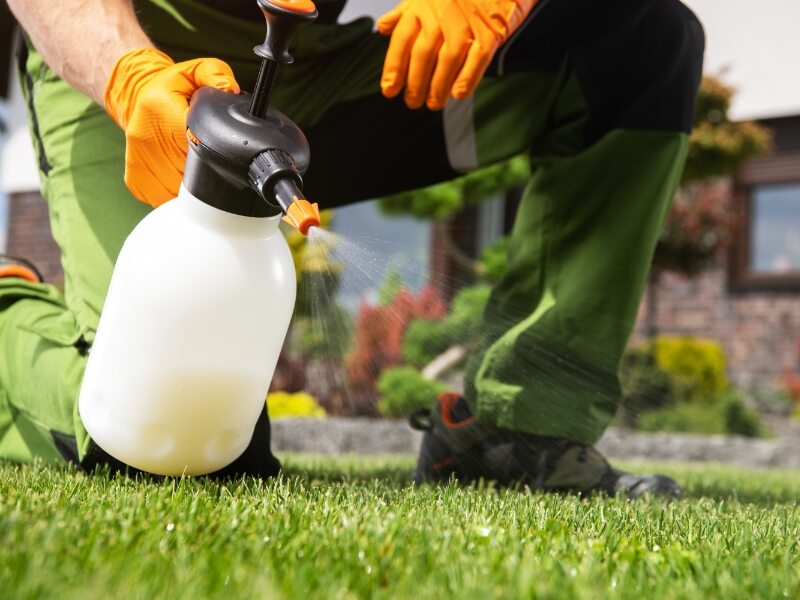
To kill weeds, if you live in Connecticut, Maine, Massachusetts, New Hampshire, New York, parts of Pennsylvania, Rhode Island, and Vermont, you will need to apply pre-emergents as soon as you can this month.
As soon as the soil temperature reaches 55 degrees Fahrenheit, you should apply your pre-emergent herbicides to kill weeds at their source before they germinate. This translates to 65 degrees Fahrenheit in air temperatures.
You can also use forsythia blooms to time your pre-emergent application. If you see these golden flowers, it’s time to apply your pre-emergent weed killer. Don’t wait for the forsythia blooms to drop.
Note: If you’re going to dethatch and aerate your lawn this spring, apply pre-emergents after. You can dethatch and aerate either before pre-emergents or postpone these procedures to fall.
Homeowners in New Jersey, parts of Pennsylvania, Delaware, Maryland, and the District of Columbia (Washington, D.C.) will need to use post-emergent herbicides this month if any weeds germinate despite their pre-emergent application. You can also hand-pull or resort to other natural weed control methods. You can learn more in our guide to weed control.
Tip 9: Overseed Bare Spots (If Needed)
For homeowners in the northern part of the Northeast, it should be warm enough to overseed your lawn. You should overseed when soil temperatures are consistently between 50 and 60 degrees Fahrenheit. This translates to around 60 to 70 degrees in air temperatures.
May is usually the last chance for homeowners in the warmer, southern part of the Northeast region to overseed cool-season grasses.
May is still generally too cold for Zoysiagrass overseeding.
Tip 10: Fertilize Your Lawn
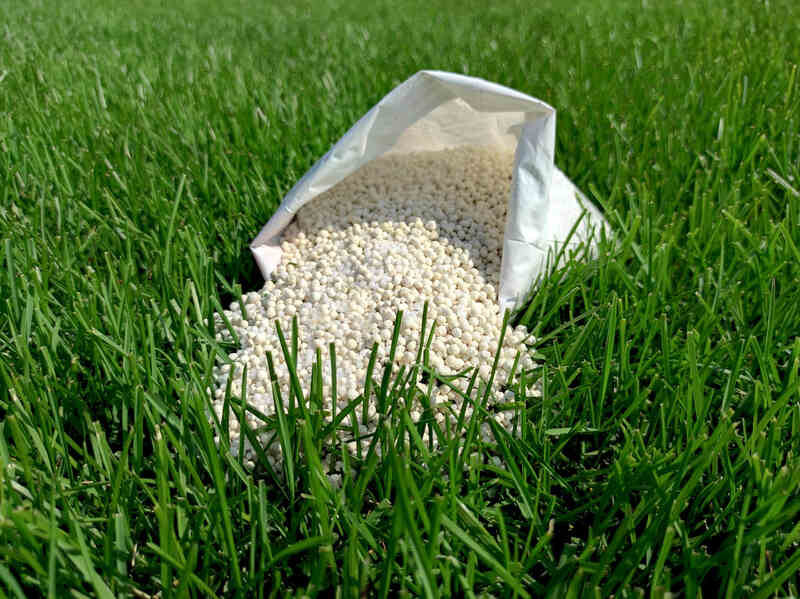
If your soil test results tell you that your soil is lacking in nutrients, you should fertilize your lawn this month. If you live in the following areas, you can fertilize your lawn when the soil reads 55 degrees (65 degrees air temperature):
- Connecticut
- Maine
- Massachusetts
- New Hampshire
- New York
- Pennsylvania
- Rhode Island
- Vermont
If you live in New Jersey, Delaware, and Maryland, this is your last chance to fertilize your lawn. However, you shouldn’t fertilize your lawn too late into May as your grass may be fed through summer. Cool-season grass goes dormant when the temperatures reach 80 degrees Fahrenheit, but it may be forced to grow (which can be stressful).
It’s generally still a little too cold to fertilize Zoysiagrass in May, even in the most southern states of the Northeast.

Top 11: Mow Your Lawn Properly
Now that it’s warmer in the northern part of the region, cool-season grass will start growing more vigorously in this area. So, homeowners in Maine, Vermont, New Hampshire, and the rest of Massachusetts and New York can probably start mowing your lawns in May.
If you live in the rest of the region, you should keep mowing your lawn, usually once a week (but possibly more).
Zoysiagrass will start growing a little faster as the temperatures continue to warm up in the southern half of the region. Homeowners with Zoysia lawns will likely need to mow their lawns in May.
For reference, here is a table of the recommended mow heights for grasses in the Northeast region:
| Grass Type | Recommended Mow Height (Inches) | Cut When Grass is This Tall (inches) |
| Fine fescue | 1.5 – 4 | 2.25 – 5.25 |
| Kentucky bluegrass | 2.5 – 3.5 | 3.25 – 4.5 |
| Perennial ryegrass | 1.5 – 2.5 | 2 – 3.25 |
| Tall fescue | 1.5 – 3 | 2.5 – 4 |
| Creeping bentgrass | 0.125 – 0.5 | 0.5 – 0.75 |
| Colonial bentgrass | 0.5 – 1 | 0.75 – 1.5 |
| Zoysiagrass (southmost areas) | 1 – 2 | 1.5 – 3 |
Tip 12: Prepare Your Sprinkler System for Spring
Historically, the northern half of the Northeast region will have the last spring frost dates in May, with only the most inland parts of Maine, New Hampshire, and New York experiencing them as late as the first week of June.
Homeowners should restart their sprinklers as soon as all threats of frost have passed. Otherwise, water may freeze in the pipes and damage the system. We already covered how to restart your irrigation system in the April section, but you need to go slow so as not to overwhelm your sprinklers. You’ll also need to observe your sprinkler system for issues.
Tip 13: Water Your Lawn Properly
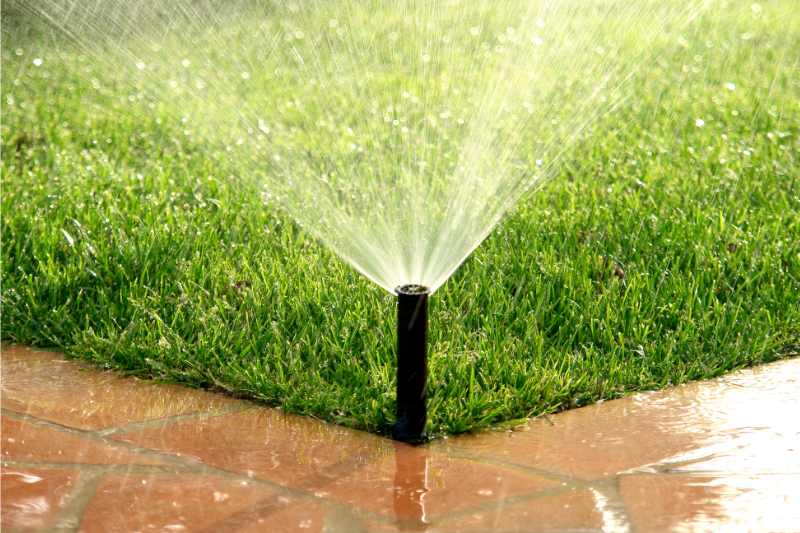
Despite the snowmelt and the spring showers, you will need to water your lawn at some point this spring. Proper irrigation is crucial to good lawn health and disease prevention. Here are some lawn watering tips:
- Water your lawn early in the morning. This is the best time to water your lawn. You want to water your grass before it gets too hot so your lawn has ample time to dry off before the chilly evening temperatures set in. We don’t recommend programming your sprinklers to turn on past 10 a.m.
- Water infrequently but deeply. Your grass will benefit from infrequent and deep watering because it encourages healthy root growth, which will help your grass become more resilient (which is helpful for the coming summer).
- Don’t overwater. Your grass only needs this much water every week:
- Cool-season grass: 1 to 1.5 inches
- Zoysiagrass: 1 inch
Are your sprinklers putting out the right amount of water? You can do the tuna can test to test your sprinkler system’s water output:
- Place tuna cans around your lawn.
- Run your sprinklers for 15 minutes.
- Measure how much water is in each can with a ruler.
- Average out the measurements.
This table shows how long you should run your sprinklers based on the average water measurement:
| Average water depth after 15 minutes | Total minutes needed to water 1 inch |
| ⅛ inch | 120 |
| ¼ inch | 60 |
| ½ inch | 30 |
| ¾ inch | 20 |
| 1 inch | 15 |

Tip 14: Continue Landscaping
If you are in New York, Massachusetts, Vermont, New Hampshire, Maine, and northern half of Pennsylvania you can start preparing your flower beds once the last frost of spring has passed. Historically, these areas have their last frost dates in May.
We covered landscaping in the April section, but you want to check your soil before adding new plants. You also want to deadhead flowers to promote flowering this spring. It’s also a good time to lay down mulch.
Homeowners in the rest of the region should continue landscaping.
Tip 15: Watch for Lawn Pests
As the weather warms up in the northern half of the Northeast, you might find pests chewing up your lawn and landscaping. Keep an eye out for damage on your plants and try to find the culprit. We covered lawn pest control in the April section.
The most notorious bugs to watch out for are white grubs, chinch bugs, and sod webworms. You may also deal with ants.
FAQ About Spring Lawn Care in the Northeast
How Do I Make My Grass Green in Spring?
To make your grass green in spring, take care of it properly. However, you can also use iron-rich fertilizer if your grass is yellowing. Yellowing grass may be a sign of iron chlorosis – basically an iron deficiency.
If you have a Zoysia lawn, you can overseed with annual ryegrass in the fall to maintain a green lawn throughout the winter and spring. You can also switch to a cool-season lawn, which will stay green in the winter, but might turn brown in the summer.
Should I Mow High in Spring?
We recommend mowing on the higher range of the recommended mowing height, especially if you have cool-season turf.
Which Grasses Are Low-Maintenance?
The most low-maintenance grasses for the Northeast are fescue grasses.
If you don’t want to spend all your time caring for your lawn, then steer clear of Kentucky bluegrass (at least, by itself) and bentgrasses (they’re mostly used on golf greens for a reason!).
Hire a Lawn Care Pro to Help Out With Your Northeast Lawn
Spring is the time for Northeast lawns to bounce back from the winter cold. However, it won’t be able to recover without your help. You’ll need to stay on top of your spring lawn care routine and do critical treatments at the right times.
Not all homeowners will be able to care for their lawns; some would rather enjoy the season without worries. If that sounds like you, hire a lawn care professional to maintain your lawn.
LawnStarter’s network of local pros are reliable and capable of giving your lawn the TLC it needs to green up this spring. Hire a local lawn care pro through LawnStarter today.
Main Photo Credit: Background Photo – MariuszBlach / Canva Pro / License, created using Canva Pro and Infogram


